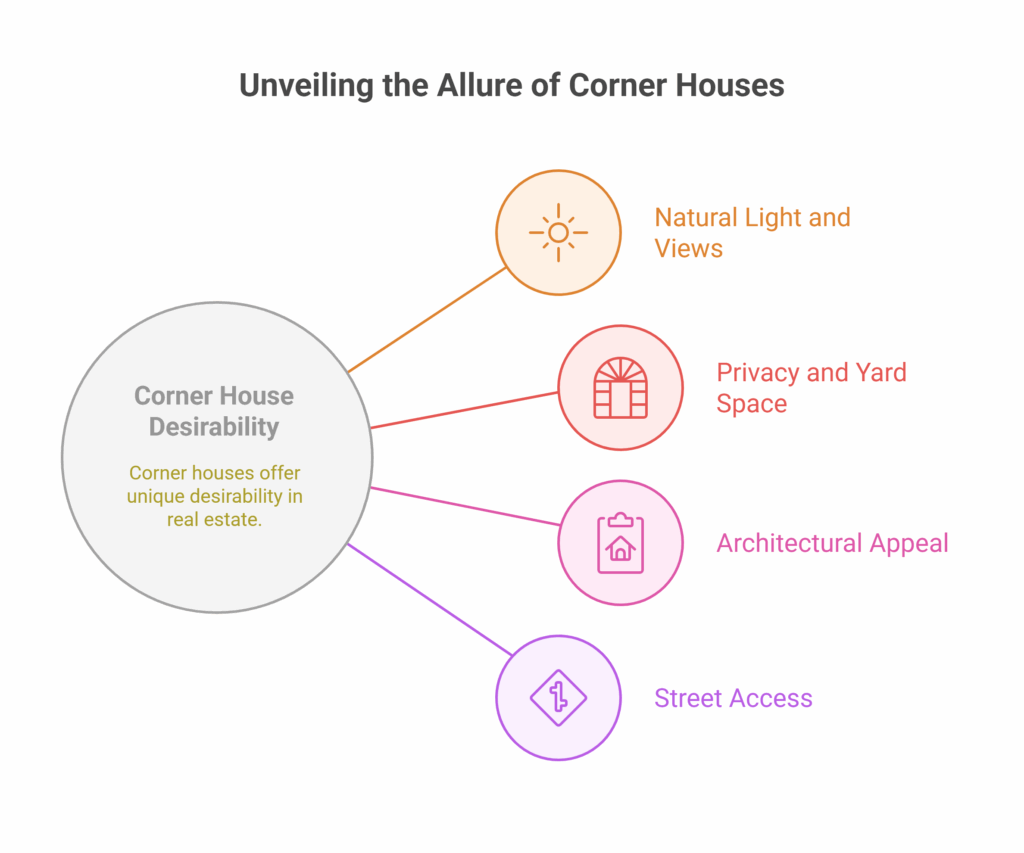Quick Answer: Why Are Corner Houses More Expensive?
“Why Are Corner Houses More Expensive?” is a question many homebuyers ask, and the answer lies in a mix of space, visibility, and desirability. Corner houses often come with larger lots, offering extra yard space, more natural light, and fewer immediate neighbors—features that appeal to many families. Their dual street access also makes them convenient for parking and remodeling options. On top of that, corner properties stand out more, boosting curb appeal and potential resale value. Of course, with these perks come higher demand and, naturally, higher prices.
Think of it like ordering a window seat on a plane—same destination, but you pay extra for the view. That’s essentially “Why Are Corner Houses More Expensive?”
Now let’s dive deeper.

1. More Land, More Space
One of the biggest reasons corner houses are priced higher is that they typically occupy more land than their mid-block counterparts. Since they sit at the intersection of two streets, corner lots often extend further or have unique layouts that provide a larger yard or additional frontage. This extra outdoor space is highly valuable to many homebuyers, especially families with kids or those who want a garden, play area, or even space to build an extension or add a garage.
In areas where lot size is at a premium—like in urban or high-density suburban neighborhoods—a larger lot can significantly increase a home’s overall market value.
2. Better Natural Light and Ventilation
Corner homes usually have more windows and fewer adjacent walls. With more sides of the house exposed to the outside, these homes allow for better natural lighting and improved airflow throughout the day. This can enhance the home’s interior ambiance, reduce energy usage for lighting and cooling, and create a more pleasant living environment overall.
In warm climates like El Paso, this improved ventilation can be a strong selling point.
3. Greater Curb Appeal
Curb appeal plays a major role in real estate value. A home that looks inviting and well-maintained from the outside often generates more interest and sells faster—and for a better price. Corner houses typically have more sidewalk frontage and landscaping opportunities, allowing owners to create a more visually striking exterior.
A well-landscaped corner property stands out more easily than one nestled between two other homes, giving it a distinctive and attractive look that can justify a higher price.
4. Increased Privacy and Fewer Shared Walls
In many residential layouts, corner houses only share a fence or wall with one neighbor rather than being bordered on both sides. This can lead to increased privacy, reduced noise, and a more peaceful living experience.
This factor becomes especially important in tightly packed neighborhoods or in townhome communities where privacy is limited. The extra buffer from neighboring homes is a significant draw for buyers willing to pay more for comfort and peace of mind.
5. Unique Architectural Opportunities
Due to their larger or irregular lot shapes, corner homes often have unique floor plans or designs not found in the rest of the neighborhood. Builders and architects may take advantage of the corner position to include features such as wraparound porches, side garages, or dual-entry driveways.
For homeowners who prefer homes with character or uniqueness, this architectural distinction can be a big plus, further contributing to the home’s higher value.
6. Potential for Multiple Access Points
Corner homes often offer multiple access points—from both streets—which can be highly practical. For instance, it’s easier to create dual driveways or access detached garages from a side street. This can be a big benefit for families with multiple vehicles or for homeowners running a business from their home.
In cities where parking is tight, this kind of flexibility can add significant convenience and value.
7. Ideal for Commercial or Mixed-Use Potential
In certain zoning areas, corner lots are more desirable for future commercial or mixed-use development. Businesses like coffee shops, salons, or professional offices prefer corner properties for higher visibility and accessibility.
While this isn’t relevant to all homeowners, the potential for future rezoning or development can make a corner home a smarter investment, especially in growing markets.
But What About the Downsides?
While corner houses offer many benefits, they aren’t without their drawbacks. Some of the potential downsides include:
- Increased street noise: With exposure to two streets, there may be more traffic noise or foot traffic.
- Higher maintenance: More sidewalk and lawn area can mean higher upkeep costs.
- Less backyard privacy: The additional frontage may come at the expense of a more secluded backyard.
- Security concerns: More exposure means more entry points, which could be a concern in some areas.
However, for many buyers, the advantages far outweigh the drawbacks—especially when considering long-term resale value.
Final Thoughts
Corner houses are more expensive for a variety of good reasons: larger lots, improved lighting and airflow, unique designs, added privacy, and greater curb appeal. These attributes combine to create a property that not only looks and feels better but also holds stronger investment potential.
That said, whether a corner home is worth the higher price depends on your individual priorities and lifestyle. If you value space, flexibility, and standout features, the premium may be well worth it.
If you’re looking to sell your corner home fast or want to explore your selling options without the hassle of repairs or staging, working with El Paso cash home buyers could be the ideal solution. They can help you unlock the value of your property quickly and efficiently.
Call us anytime at 713-561-5162 or connect with us on our website and we’ll lay out all of your options for your specific situation.
